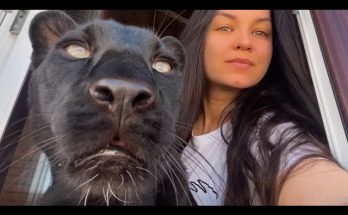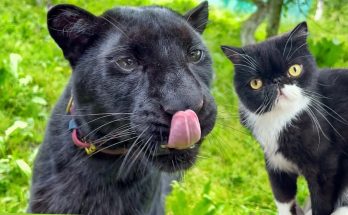The Story Behind the Internet’s Favorite Black Panther
Luna, the stunning black panther with her sleek black fur and striking golden eyes, has won the hearts of millions on social media. Her life is a tale of resilience, friendship, and a peek into the world of an extraordinary creature. As more people become enchanted by Luna, her story sheds light on the intricate relationship between humans and wild animals, emphasizing the unique bond that can develop when respect, understanding, and care are prioritized.

The Early Days: A Fragile Start
Luna was born in a wildlife reserve in Siberia, Russia, a place where black panthers, a rare melanistic variant of the leopard, are seldom spotted in the wild. Melanism, the genetic trait responsible for Luna’s beautiful black coat, is uncommon in leopards and even more so in colder regions like Siberia. While leopards typically thrive in warmer climates across Asia and Africa, Luna came into the world as part of a breeding program for exotic animals.

Sadly, Luna’s mother rejected her shortly after she was born, putting her survival at great risk. Without a mother to nurse and care for her, Luna faced serious health challenges. Fortunately, a compassionate young woman who worked with animals stepped in to provide the care Luna desperately needed, giving her a fighting chance at life.
A Special Bond with a Caregiver
Luna’s rescuer, Victoria, brought a wealth of experience in working with wild animals, which was essential for Luna’s survival. From bottle-feeding her to ensuring she received the right nutrients for healthy growth, Victoria took on the significant responsibility of raising a wild panther cub. This was far from a typical domesticated animal rescue; Victoria had to find a balance between Luna’s wild instincts and her specific care needs.

In those early months, a special bond formed between Victoria and Luna. As Victoria welcomed Luna into her home, the young cub started to feel comfortable in a domestic environment, developing a connection with her caregiver. However, Victoria remained aware that Luna was still a wild animal, taking great care to respect her natural instincts and create a space that met her needs.
Living as a Domesticated Wild Animal
Raising a panther at home presents a unique set of challenges and responsibilities. As Luna matured, her natural instincts and physical abilities became more pronounced. Panthers are renowned for their agility, strength, and solitary tendencies. Creating an appropriate environment required ample space, stimulation, and a deep understanding of her species’ behaviors.

Victoria ensured that Luna had access to toys and activities that encouraged her to explore and exercise her natural instincts, mimicking the wild environment where she would have thrived. Luna’s daily routine involved climbing, running, and engaging with enrichment items designed to keep her mentally stimulated, along with plenty of social interaction to strengthen her bond with Victoria.
A Social Media Sensation
AsLuna’s story unfolded, Victoria started posting photos and videos of Luna’s daily adventures on social media. Almost immediately, the internet was enchanted by the sight of this sleek, powerful creature bonding affectionately with her caregiver. Luna’s stunning beauty and her heartwarming relationship with Victoria quickly attracted a global following, turning her into a social media sensation. Videos of Luna cuddling, playing, or just lounging around the house rapidly racked up millions of views.
However, this newfound fame came with its ups and downs. While it sparked a greater appreciation and curiosity about panthers and big cats in general, it also raised questions about whether wild animals should be kept in domestic environments. Victoria was always candid about the challenges of caring for a wild animal and made it a point to educate her followers about the responsibilities involved, stressing that these animals are not pets in the usual sense.
Understanding Black Panthers and Melanism
Luna’s beautiful black coat is due to melanism, a genetic mutation that leads to increased dark pigmentation. Black panthers aren’t a distinct species; they are actually leopards (or jaguars in the Americas) that exhibit these melanistic traits. This genetic feature offers a form of camouflage in their natural environments, allowing them to blend into the shadows of dense forests. Such adaptation enhances their hunting efficiency by making it easier to ambush their prey.
Although Luna’s melanistic coat gives her a striking look, it also presents specific health challenges, as her species isn’t naturally suited to cold climates like those in Siberia. Caring for Luna requires careful management of her surroundings to ensure her health and well-being in conditions that differ significantly from those of her tropical and subtropical relatives.
The Debate: Wild Animals and Human Interaction
Luna’s story brings up an important question: should we domesticate wild animals, even if they are orphaned or abandoned? Although Luna has thrived under Victoria’s care, finding the right balance is difficult. Big cats, like panthers, still have their wild instincts and need specialized care that most people aren’t equipped to provide. Additionally, having these animals in home settings can create the false impression that they can be kept as pets, which poses risks for both the animals and the humans who try to care for them.
While Luna’s experience is unique, it highlights the challenges of animal rehabilitation and the ethics surrounding domestication. In Victoria’s case, her knowledge and commitment have helped Luna flourish. However, she always emphasizes that wild animals are better off in their natural environments or in well-managed wildlife reserves, rather than in private residences.
Luna’s Lasting Impact and Legacy
Luna’s story transcends that of a stunning black panther; it serves as a beacon of hope for animal enthusiasts around the globe. She has emerged as a representative for her species, raising awareness about the obligations involved in caring for exotic animals and the difficulties they encounter in captivity. Through Luna’s narrative, Victoria has highlighted the critical need for conservation and the protection of natural habitats.
As Luna thrives under Victoria’s care, she stands as a testament to the beauty of the wild and the responsibilities that come with appreciating it. While social media has allowed millions to connect with Luna, her journey also underscores the fragile balance between human admiration and ethical duty regarding wild animals.
Conclusion
Luna’s journey serves as a powerful reminder of the challenges and beauty that arise from close interactions with wild animals. She embodies the allure and mystery of the wilderness, and her unique bond with Victoria highlights the deep connections that can develop between humans and animals. However, Luna’s story also urges us to acknowledge and respect the wild in its natural state, promoting conservation and responsible admiration from afar. As Luna continues to captivate and educate her audience, her tale will hopefully foster a greater appreciation for the wild and a dedication to its preservation.

